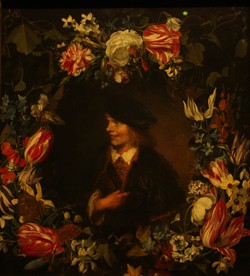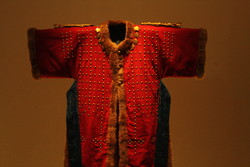In some point of your life, you must have had the experience of admiring a picture as delicate as a painting, or as enchanting as a fairy tale. In the history of humankind, paintings continued to change and develop endlessly, and new genres continuously emerged until the birth of present modern art. Among these millions of paintings, how could the so-called masterpieces keep their honor for such a long time? You will be able to realize the answer to this question in the exhibition <Six Centuries of Beauty in the Habsburg Empire>. As the name of the exhibition suggests, the exhibition showcases various masterpieces collected from the 15th century to the early 20th century by the Habsburg empire, which is famous for collecting the world's most notable paintings. The exhibition contains masterpieces that will never lose their value, including memorable artworks from the Renaissance and Baroque periods that you have to see at least once in your life if you love art. Now let's visit this exhibition with CAH!
Prague's Art Room, the Taste of the Emperor

The exhibition is divided into five parts, starting from Maximilian I in the 15th century, who was the main force of the House of Habsburg seizing hegemony in Europe, to the role of major collectors such as emperors up to the early 20th century. The first thing that catches the eyes of those who enter the exhibition is the golden sundial in the shape of a cross. It is a very technical and artistic object, almost surprising in that such a beautiful and sophisticated work was created in the 17th century. This gold sundial, made according to the latitude of Prague, has different ways of telling the time depending on if you look from the front, side, or the back. The front side tells when the sun rises and sets, and on the side, people can check the time in detail through the eight numeric keypads. Finally, from the back of the sundial, the current time and the international time can be seen at the same time. Various knowledge is intensively condensed into this one small sundial. Then people can see pictures such as ‘Jupiter, Disguised As Diana, Seducing The Nymph Callisto’. You might probably stay a long time in front of all the paintings because the characters in the pictures seem to come to life in an instant. From the expressions that reveal the emotions of the characters in the painting to the soft-looking fabrics, it takes a long time to catch all the delicate details. People will feel as if they are constantly admiring the works of the past, alongside with the emperor.
Vienna, the City of Eternal Masterpieces

From the inside of the palace to the stories of myths and the daily lives of ordinary people in real life, the masterpieces of the city of Vienna show various worlds all from the same space. The first thing you will see is the oil painting ‘Infanta Margarita Teresa in a White and Silver Dress’ painted by Velázquez around 1656. Let's take a brief look at the story of this painter and the royal family. The master of Baroque, Diego Velázquez, was chosen as the painter for the Spanish royal family at the age of 24, and painted Philip IV and his family until the painter’s death. In fact, it is said that Philip IV trusted Velázquez to the point where he had his portrait painted exclusively by Velázquez. The painter also had sincere respect for the king who recognized and invested in his talent since he was young. ‘Infanta Margarita Teresa in a White and Silver Dress’ also shows the close relationship between the painter and the royal family. Princess Margarita lived a short and dismal life, dying at the young age of 22 not long after getting married. But when people see the face of the little girl staring beyond the frame of the picture, her bleak future seems to never come. On the other side, ‘Jupiter and Mercury in the House of Philemon and Baucis’ by Peter Paul Rubens depicts mythical characters. Jupiter, the supreme god of Olympus, and Mercury, the messenger god, hide their identities and visit a human village to examine the human world. The Gods, who looked simply like two homeless men, had doors slammed in their faces by most people, but only the old couple in the picture, Philemon and Baucis, welcomed the two gods. The painting depicts a scene where an elderly couple provides comfort and welcomes the two gods.
Visiting the Palace That Has Become a Museum with Queen Maria Theresia

Passing through the magnificent and dignifying portrait of Queen Maria Theresia, who valued the importance of sharing art by revealing Habsburg's collections to the public for the first time, people can encounter the famous painting of 'Marie Antoinette, Queen of France' (Élisabeth Louise Vigée Le Brun). As rumored, people can imagine how splendid and affluent Marie Antoinette was when the painting was made, from her flashy dress and the huge feathers on the back of her head. But maybe because we all know Marie Antoinette’s tragic end, it feels like her inevitable gloomy death can be seen in her portrait. Finally, when people look at paintings like ‘Court Banquet to celebrate the Engagement of Archduchess Marie Christine to Prince Albert of Saxony’ (Johann Gottfried Auerbach) it feels as if they are celebrating a close friend’s engagement and enjoying a light snack among a lot of people. Viewers will be able to have a valuable experience looking into the palace, which retains a colorful, diverse, and complex history and story.
Evidence of Diplomatic Relations Between Austria and the Joseon Dynasty


Surprisingly, at the end of the exhibition, you can find some old armor and helmets from the Joseon Dynasty. This part of the exhibition, which comes as a surprise to people with the sudden unique atmosphere, is commemorative evidence of the diplomatic relations between Joseon and Austria. The splendid and sturdy-looking armor and helmet of Joseon, which are proudly displayed in the exhibition, were a gift given to Austrian Emperor Franz Joseph I by King Gojong of the Korean Empire in 1892 to mark the establishment of diplomatic relationship between the two countries. It makes the viewer even more proud and happy to look at the armor and helmet because rather than being stolen, they are a monument rightly exchanged in the process of establishing legitimate diplomatic ties. These Joseon artifacts brought in from Austria and were presented to Koreans for the first time, allowing viewers to get a glimpse of a well-preserved Joseon traditional armor and the positive diplomacy of the past. As the exhibition itself was held to commemorate the 130th anniversary of diplomatic ties between Austria and Korea, the traditional monuments of Joseon that prove the long-standing diplomatic ties was the perfect finale to the exhibition.
There may have been a time in life when you wondered why famous paintings remain as masterpieces. There are so many art works in the world, and the standards of beauty are constantly changing every day. But how could the masterpieces continue to be admired and highly valued by humankind? Going to the exhibition <Six Centuries of Beauty in the Habsburg Empire>, you can see for yourself why real masterpieces don’t lose their value. If you want to see the paintings that make you imagine every single movement of the brush, and admire the genius of the painters, visit the exhibition <Six Centuries of Beauty in the Habsburg Empire>.
Dates: 2022.10.25. ~ 2023.03.01.
Hours: Mon, Tue, Thu, Fri, Sun 10:00~ 18:00 (Last admission 17:20)
Wed, Sat 10:00~21:00 (Last admission 20:20)
*Closed on 1.1(New Year’s Day), 1.22(Korean New Year)
Place: Special Exhibition Hall, National Museum of Korea
Ticket Prices: Adults 17,500won/ Teenagers 15,000won/ Children 10,000won/ Todler 6,000won
Contact: 1688-0361

